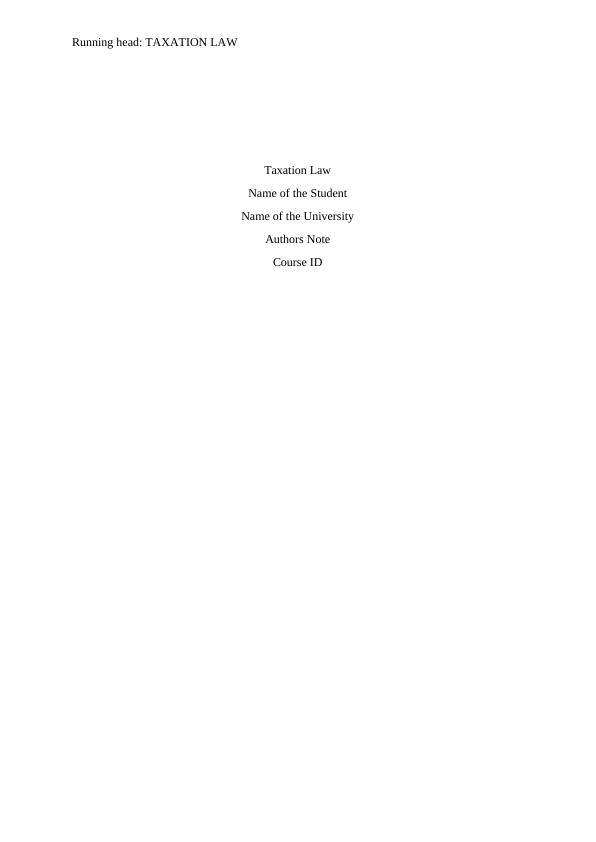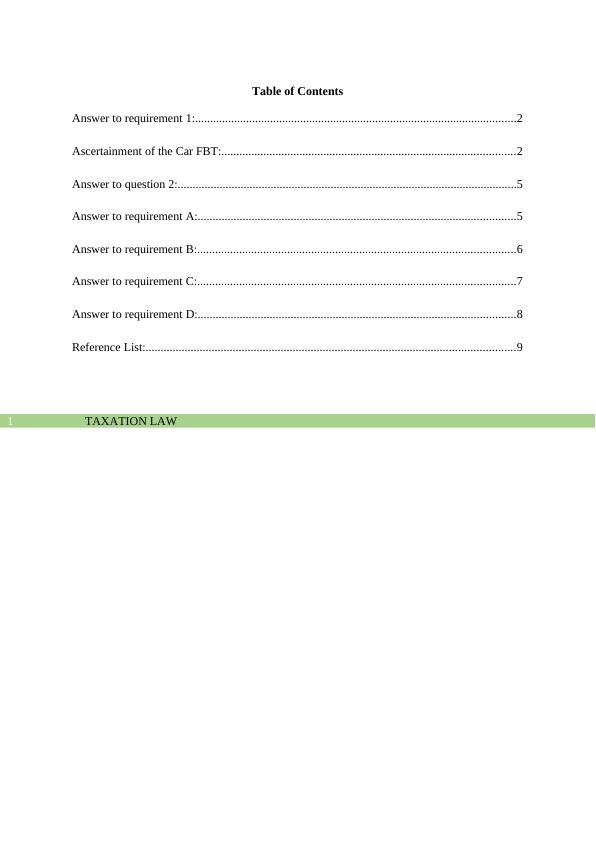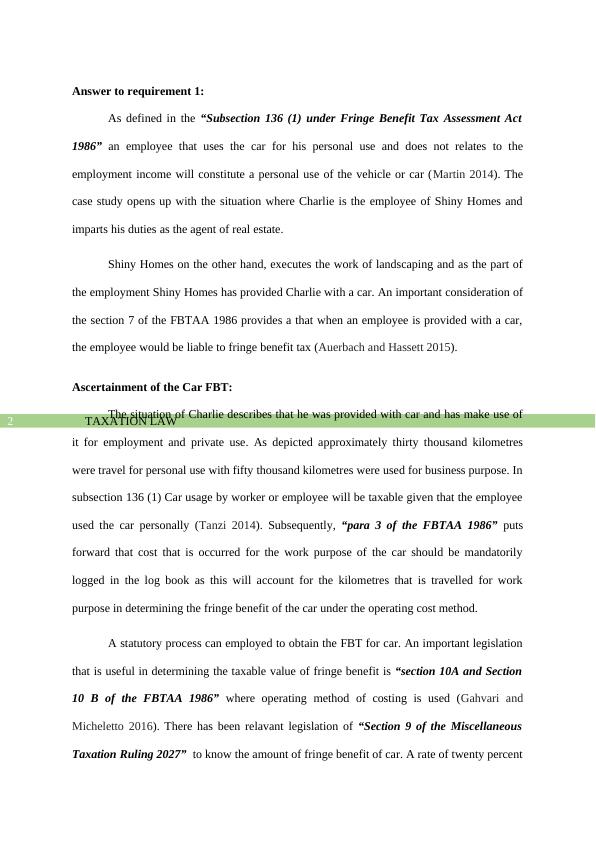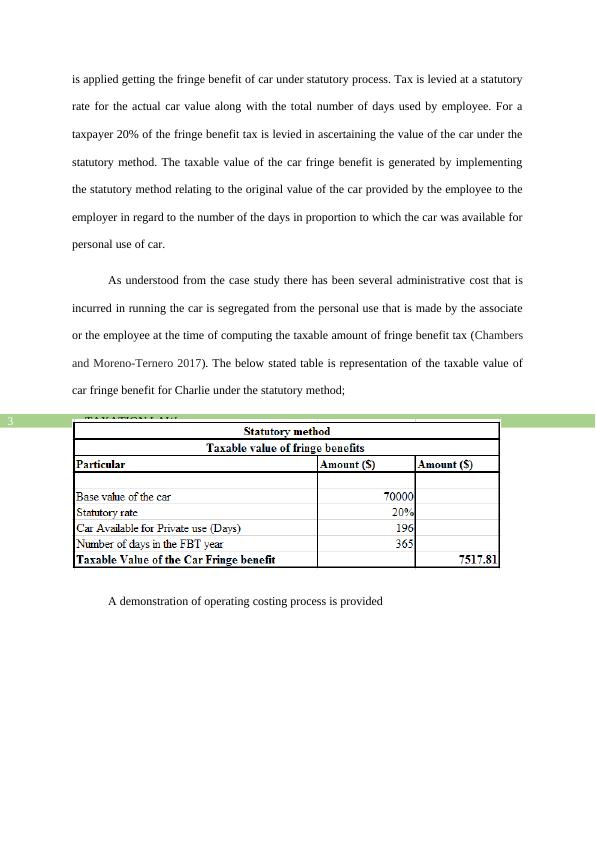Fringe Benefit Tax Assessment Act 1986
Added on 2020-05-28
11 Pages2284 Words34 Views
Running head: TAXATION LAWTaxation LawName of the StudentName of the UniversityAuthors NoteCourse ID

TAXATION LAW1Table of ContentsAnswer to requirement 1:...........................................................................................................2Ascertainment of the Car FBT:..................................................................................................2Answer to question 2:.................................................................................................................5Answer to requirement A:..........................................................................................................5Answer to requirement B:..........................................................................................................6Answer to requirement C:..........................................................................................................7Answer to requirement D:..........................................................................................................8Reference List:...........................................................................................................................9

TAXATION LAW2Answer to requirement 1: As defined in the “Subsection 136 (1) under Fringe Benefit Tax Assessment Act1986” an employee that uses the car for his personal use and does not relates to theemployment income will constitute a personal use of the vehicle or car (Martin 2014). Thecase study opens up with the situation where Charlie is the employee of Shiny Homes andimparts his duties as the agent of real estate. Shiny Homes on the other hand, executes the work of landscaping and as the part ofthe employment Shiny Homes has provided Charlie with a car. An important consideration ofthe section 7 of the FBTAA 1986 provides a that when an employee is provided with a car,the employee would be liable to fringe benefit tax (Auerbach and Hassett 2015). Ascertainment of the Car FBT:The situation of Charlie describes that he was provided with car and has make use ofit for employment and private use. As depicted approximately thirty thousand kilometreswere travel for personal use with fifty thousand kilometres were used for business purpose. Insubsection 136 (1) Car usage by worker or employee will be taxable given that the employeeused the car personally (Tanzi 2014). Subsequently, “para 3 of the FBTAA 1986” putsforward that cost that is occurred for the work purpose of the car should be mandatorilylogged in the log book as this will account for the kilometres that is travelled for workpurpose in determining the fringe benefit of the car under the operating cost method. A statutory process can employed to obtain the FBT for car. An important legislationthat is useful in determining the taxable value of fringe benefit is “section 10A and Section10 B of the FBTAA 1986” where operating method of costing is used (Gahvari andMicheletto 2016). There has been relavant legislation of “Section 9 of the MiscellaneousTaxation Ruling 2027” to know the amount of fringe benefit of car. A rate of twenty percent

TAXATION LAW3is applied getting the fringe benefit of car under statutory process. Tax is levied at a statutoryrate for the actual car value along with the total number of days used by employee. For ataxpayer 20% of the fringe benefit tax is levied in ascertaining the value of the car under thestatutory method. The taxable value of the car fringe benefit is generated by implementingthe statutory method relating to the original value of the car provided by the employee to theemployer in regard to the number of the days in proportion to which the car was available forpersonal use of car. As understood from the case study there has been several administrative cost that isincurred in running the car is segregated from the personal use that is made by the associateor the employee at the time of computing the taxable amount of fringe benefit tax (Chambersand Moreno-Ternero 2017). The below stated table is representation of the taxable value ofcar fringe benefit for Charlie under the statutory method; A demonstration of operating costing process is provided

End of preview
Want to access all the pages? Upload your documents or become a member.
Related Documents
Australian Taxation Law - PDFlg...
|12
|2448
|99
Assignment on Taxation Lawlg...
|14
|3084
|39
Taxation Law Assignment - Fringe Benefit Taxlg...
|8
|1309
|36
Answer to question 1: Taxation Law Name of the Student Name of the University Authorslg...
|12
|2450
|268
Case Study - Taxation Lawlg...
|10
|1748
|51
Benefits Tax Assessment Act 1986lg...
|13
|2290
|68
